“A man’s tent is like a god’s temple.”
— Kyrgyz proverb
It occurred to me a few weeks ago that perhaps I was getting ahead of myself – that I’d been so focused on sharing stories and sketches from my own little Salt Spring yurt, that I had failed to zoom out and explain the history of yurts in general – you know, where exactly they come from and just how long they’ve been around.
So I did something I haven’t done in a while – I dusted off my researcher’s hat and got to work. By way of several internet vortexes, I discovered beautiful essays such as this piece on Central Asian nomads, adapted for the Smithsonian Folklife Festival, and articles such as this one that are so chock full of facts I couldn’t take notes fast enough.
What I found was rather fascinating – at least it was to this yurt-dwelling wanna-be cultural anthropologist. I’ve always been fascinated by other cultures and by the ways they live their lives. My dream assignment would involve being sent to live with an entirely unknown people group and simply getting to document their habits, their lifestyle, their families, their homes. Although I’m aware the chances of such a people being discovered in today’s world are slim, a girl can hope, right?
But reading about the story of yurts rekindled that fascination – and I hope you’ll humor me today as I share a bit of what I read here. Because what I found was this – yurts are ancient. They have a history dating back over two millennia, and some of our earliest explorers wrote about them.
And the more I read, the more I looked at my own yurt differently – not as some personal island escape, but a part of something much, much bigger.
The first thing I was surprised to learn was that the word ‘yurt’ itself, the term most commonly used by Westerners, is actually Russian in origin, while Mongolians have their own word for their felt-walled home – ger. And in Turkic nations such as Turkmenistan, Kazakhstan, and Kyrgyzstan, yurts are called kiyiz üy, which translates as ‘felt house.’
All of these people groups are traditionally nomadic. Both the wild animals they hunt and the domestic livestock they raise – herds of cattle and camels, sheep and goats, and especially horses – necessitate a pattern of migratory movement for fresh grazing. The term ‘nomad’ itself even comes from the Greek word for pasture, nomos. They move at least twice a year but often more, shifting with the seasons, lifting and lowering their light round homes in as little as 45 minutes.
I was also surprised to learn that Mongolians are quite superstitious, and that they have all sorts of rituals and taboos and beliefs governing life in a ger. Instead of knocking, you should call out “Nokhoi khor,” which translates as “hold the dog,” and bow your head before entering – even if no one’s home. You should walk around the ger clockwise, from left to right, following the path of the sun. You shouldn’t lean against the walls or support poles, as these are symbols of stability, and if you stay the night, you should sleep with your feet pointing towards the door.
The list goes on, but what intrigued me even more than the taboos was the reasoning behind them – the fact that yurts hold a great amount of meaning for the families who call them home.
“The ger is more than their traveling shelter on the Asian steppes,” one article says. “It is their centering point in a moving universe.”
I am a lover of symbols – for objects that have one meaning, but point towards another layer of meaning beneath them. For Mongolians – and for other tribes of Central Asian nomads as well – the yurt seems to be such a symbol.
“Nomadic life is marked by eternal circles,” writes Alma Kunanbay in the same Smithsonian essay I mentioned earlier, “the circle of the sun, the open steppe, the circumference of the yurt, the horned circular scroll of ornaments…The completion of one circle leads to the beginning of the next.”
Before diving into my first vortex of research last week, this was something I’d already observed about my own experience of yurt living – how it’s really a series of concentric circles: from the circle of Salt Spring (an island that isn’t quite circular, but still) to the circle of fir and pine trees surrounding my yard to the circle of the yurt itself, endless layers of rings ever narrowing like an hourglass to their connecting apex – the fishbowl bubble of a window in the roof. And it’s there that it all begins to widen again, from the circle of the globe window to the greater globe of the sky above.
Sitting here beneath the window now, I find it has an almost spiritual effect – the bowed glass forever pulling at your gaze, your eyes magnetically drawn to the billowing clouds and branches and, at night, the panoply of stars and occasionally the moon itself. Even the yurt’s roof poles, all angled towards the window in perfect parallel lines, seem to say the same thing: look up, look up, look up.
And so what I was most thrilled to learn last week is that when it comes to my obsession with the circle at the center of my roof, I’m rather late to the game – that Mongolians and their Turkic neighbors have always placed a special amount of significance on the crown of their homes.
Instead of a plexiglass bubble, they have a carved wooden ring called a tono, or shanyrak in Turkic, which acts as a smoke hole. While the rest of the yurt may be replaced – the willow lattice walls, the roof poles, the felt – the crown is passed down for generations, typically from father to youngest son. “It is a symbol of home and family and represents an opening up to the world,” writes this article.
While my own crown is considerably less decorated than its Central Asian counterpart, it still serves the same purpose. It serves to bring the outside world in, while at the same time bringing me to a deeper sense of connection with the world.


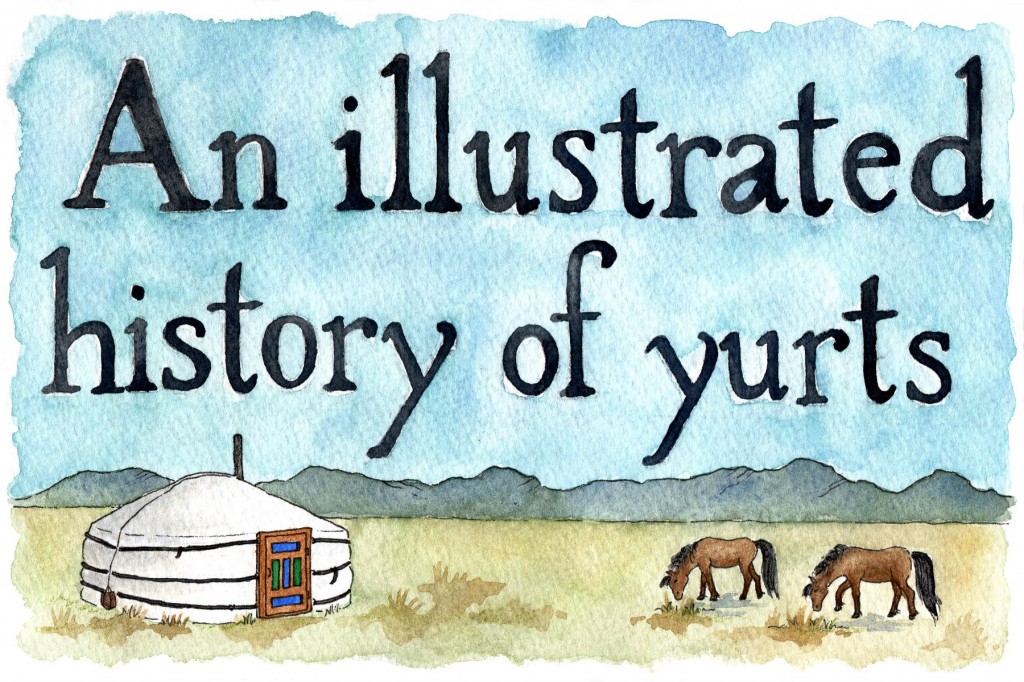
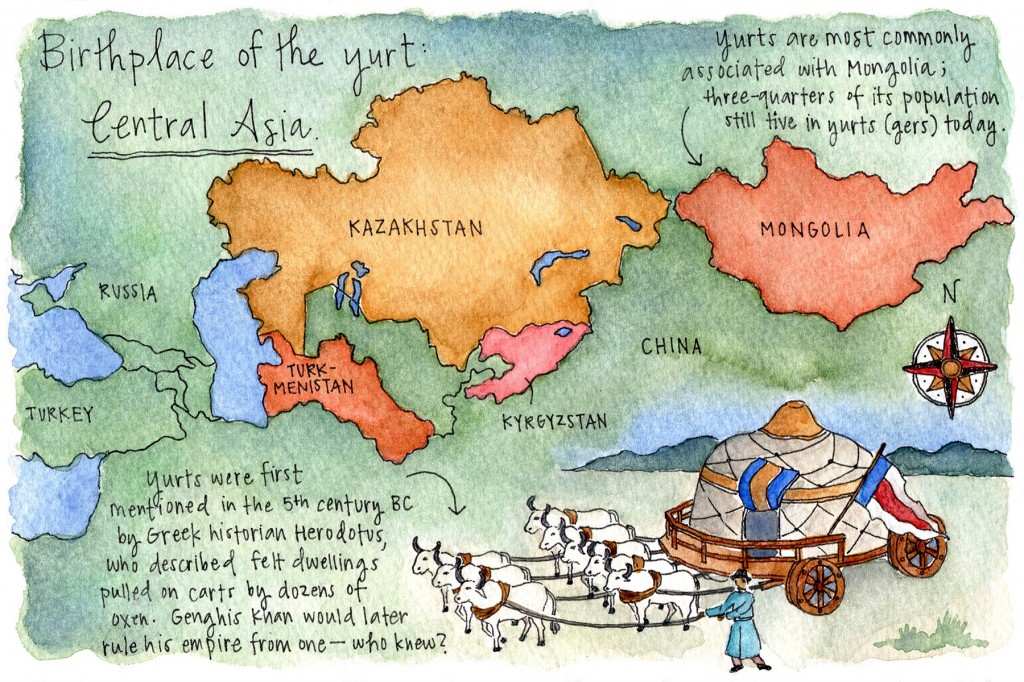
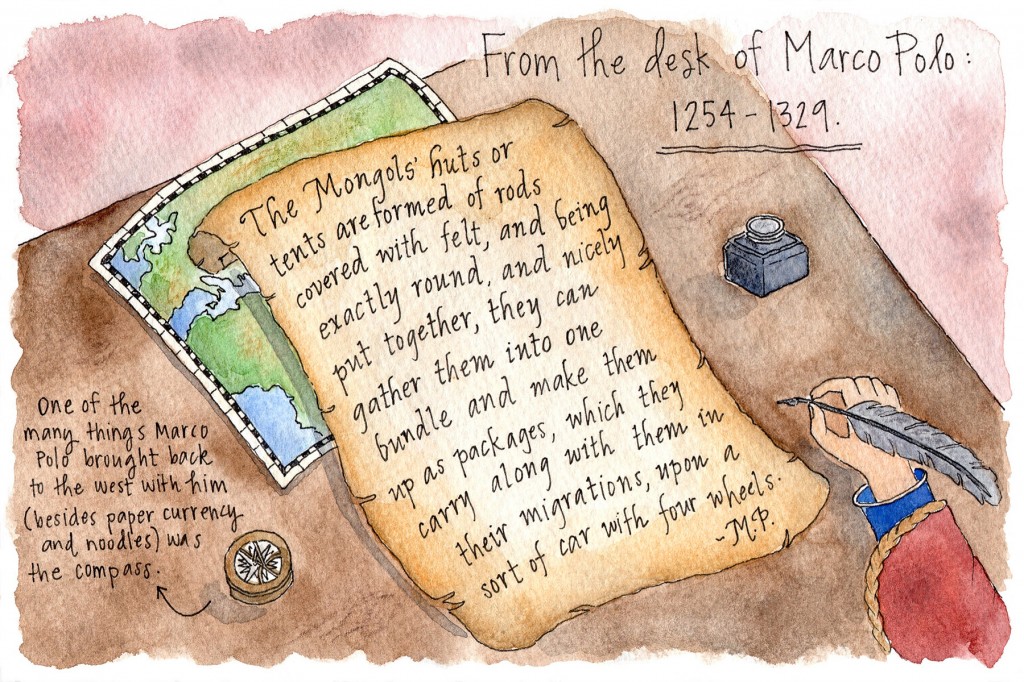
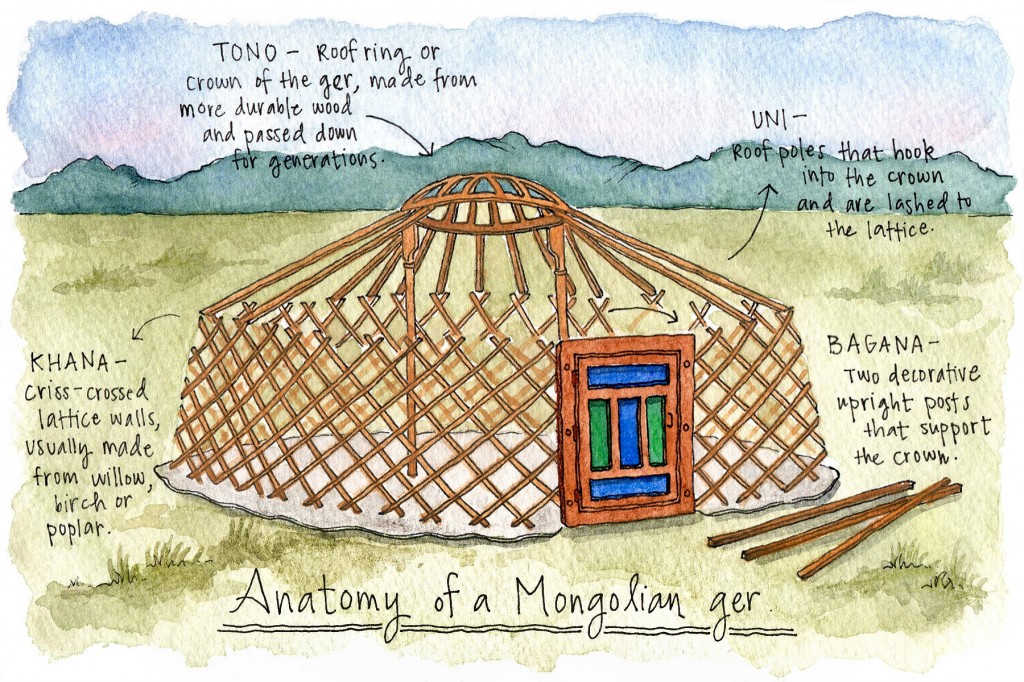
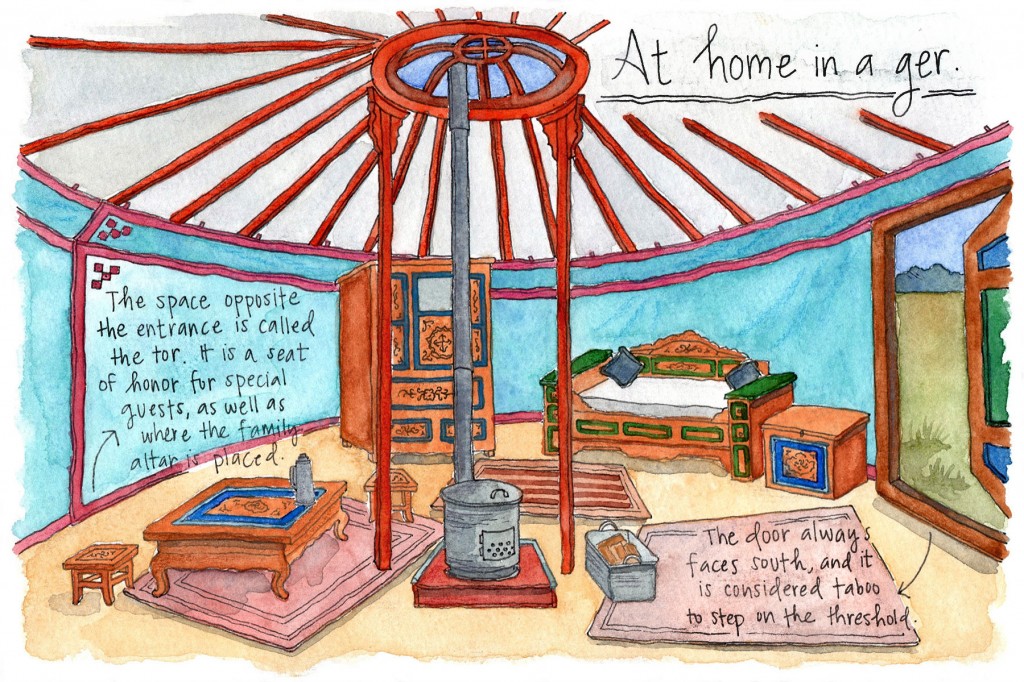
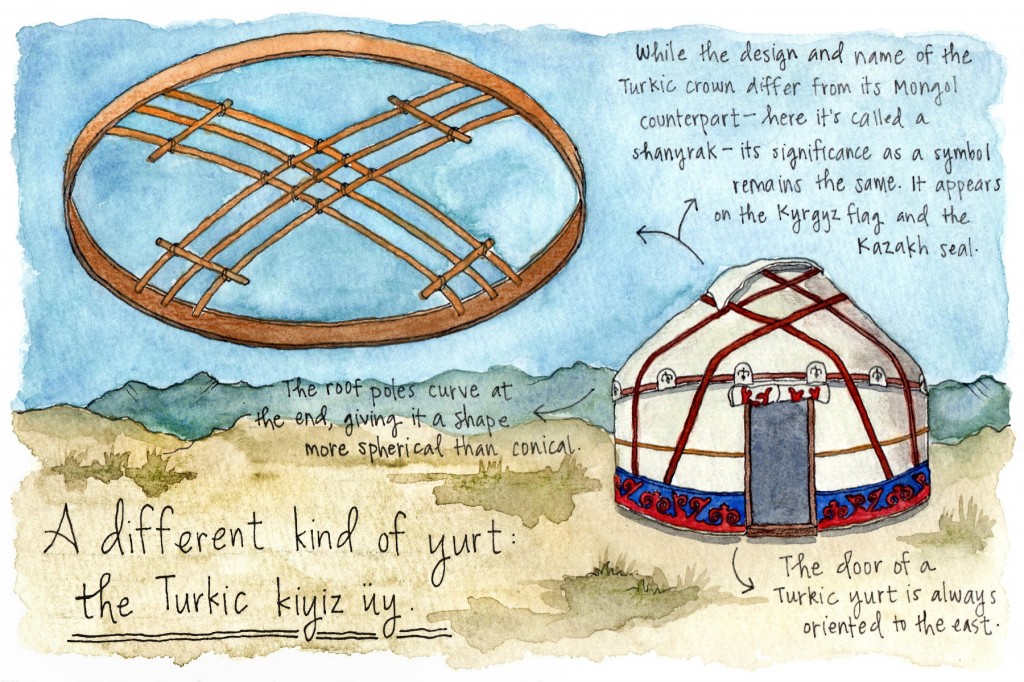
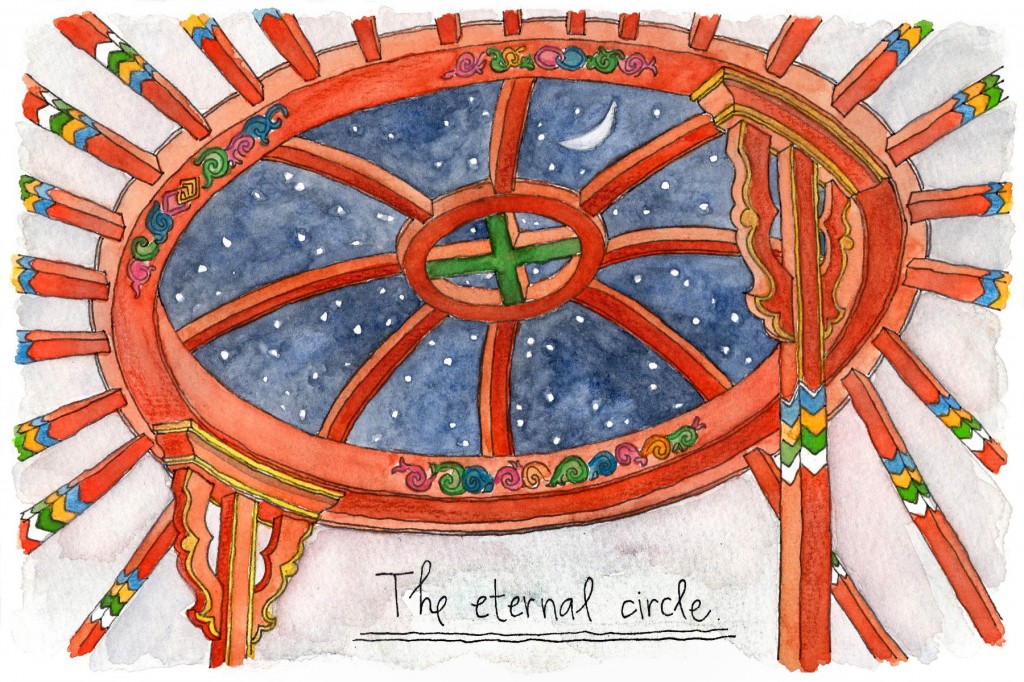
I have always wanted to stay in a yurt. Great detailed explanation and illustrations!
I really hope you’ll get the chance to soon, Angela! I’ve so loved my own little yurt and can’t recommend it enough 🙂
Of course, your sketches are so noteworthy, and informative. I truly enjoyed the article especially “the crown” and how it is passed from generation to generation. I really want to live in a yurt…
Thank you, Susie! Learning about the crown was definitely my favorite little discovery as well – both because I loved learning about its significance to Mongol families, but also for how I’ve loved my own globe window so much. Hope you and the kiddos are having a fantastic week so far! xo
Oh thanks for that Candace! I really enjoyed learning about the yurts and their cultural importance–such things always fascinate me. I love learning about how other people lived. That’s one thing I look forward to about traveling. Just learning other people’s history. It can be so beautiful. There is so much beauty to be seen if only we have the openness to go out and learn about it–and with it often comes a sort of wisdom. I think I’ll save this, for if ever I include yurts in a story. 😉
Elora, I really couldn’t have said any of that better myself – thank you for sharing your beautiful insights with us! I especially love what you said here: “There is so much beauty to be seen if only we have the openness to go out and learn about it.” That’s pretty much one of the driving forces behind why I travel, so I really appreciate you putting it so perfectly. I’m so looking forward to reading your stories, and thank you for stopping by to read mine!
Wow, I didn’t realise there was so much symbolism in a Yurt! Every day is a school day right? Thanks for sharing all this Candace and I love the illustrations!
Indeed it is! I’m so glad you enjoyed learning a bit about yurts – I thought the symbolism was rather fascinating, and hoped others might enjoy reading about it here too 🙂 Thanks for saying hello, Jade, and I hope all is well in Korea!
I love symbols too! Gorgeous illustrations!!!
Thank you, Andi!! And I’m happy to hear we share a love for symbols 🙂
What a lovely essay and a great history lesson on Yurts. One of my favorite types of abodes although I have yet to stay in one. You have certainly motivated me to do so sooner rather than later however.
Thank you, Anwar! And I’ll have to start doing some research and see if there’s any to rent on the East Coast. While I was reading up for this post last week, I kept stumbling across information about tipis, so now I’m intrigued to stay in one of those as well. Perhaps that’ll be where I hole up to work on my next book 🙂 Hope you’re doing very well!
Thanks for that article and all the links you provided.
I particularly enjoyed your sketches filled with colours and information. They definitely reinforced my curiosity towards the cultures in Central Asia.
I’m happy you enjoyed the post, Allysse! And I absolutely share your curiosity with Central Asia – I’ve long wanted to visit Mongolia and the ‘Stans, and getting to live in a yurt has only reinforced that desire 🙂
Beautiful drawings! I learnt a lot 🙂 In my hometown we have a pub inside of a yurt which is awesome, I would love to stay in a yurt one day!
Thanks, Christie! And a pub inside a yurt? I’m not sure I could imagine a better combination 🙂 May I ask where your hometown is? I’d love to visit this epic pub-in-a-yurt one day!
I’ve never thought of staying in a yurt before, after reading this great illustrated post I really want to try now 🙂
You really must, Franca! I can’t recommend yurt living enough 🙂
Intriguing write-up and lovely sketches as usual Candace! I really like how nomadic people celebrate “home” and how traditions and rituals form such an important part of life.
Thanks for the excursion into history! I love the eternal circle and it reminds me quite a lot of a giant dreamcatcher… 🙂
There was one line that brought a cheeky smile to my face: I wish the “kiyiz üy” would translate “felt home”! That way it would be a marvellous play of words – my felt home and I felt home… Home is where your yurt is, right!? 😉
Thank you, Oliver! I am right there with you on loving the rituals you normally find in place among nomadic people groups – I wonder if, in lieu of a more stable home environment, these rituals and traditions form a kind of figurative home for each family? I also loved what the Smithsonian article said about how important community is to them: “Yet what remains constant for the nomad is the sensation of a natural rhythm of movement, stable forms of social organization, and abiding relationships among people.” And lastly, I’m fairly certain that you pointing out how the tono resembles a dreamcatcher made my week. As I’ve actually got a small dreamcatcher hanging on the wall of my yurt right now, that was such a fun comparison to think about. Home is indeed where the yurt is 😉
Where I grew up, we had a yurt on our property that a friend of the family lived in. For the longest time (into my 20s) – I thought that ‘yurt’ was just the name of the house that Lee lived in! It wasn’t until I heard about the yurts on the Oregon Coast where you could go camp in that I realized it wasn’t just the name given by my hippie parents and their friends!
That is the best story, Aurora – thanks so much for sharing it 🙂 No doubt I would’ve thought the same thing! Did you ever have a chance to camp in the yurts in Oregon?
Yes — those yurts are GREAT! So fun — especially in the winter/off season (summer gets a bit crazy!)
I can imagine! I’ve actually really enjoyed my little yurt in the late winter/spring season as well – it’s been fun to cozy up in against the brisk nights 🙂
History can be so much fun to learn/read when you have drawings to go with them, especially if said drawings are your stunning sketches 🙂 Beautiful illustrations, Candace!
Haha, you are too kind, Pauline! I was indeed hoping the sketches might enliven this little history lesson, so I’m glad you enjoyed them 😉 PS – Getting excited about your trip out west soon? Let me know if you’d like any recs for Seattle or Vancouver! xo
Wonderful article Candace, as well as beautiful sketches. I must get “The Weeping Camel” once more from Netflix (I did recommend it to you earlier) to home in on things I might have missed about living in a yurt in Mongolia as I was caught up in the story. Happy trails.
I’m so glad you enjoyed the story and sketches, Roberta, and thank you as well for bringing up that recommendation again! I’m planning to spend a week or two at home in Virginia this summer, and as I know my parents have a Netflix subscription, I’ll definitely make sure we watch “The Weeping Camel” while I’m there 🙂 I hope you’re doing very well!
This was a really interesting post, and your sketches were lovely as always. I’ve never stayed in a yurt before, but now I’m thinking I’ve been missing out!
Thanks, Laura! While I would never tell anyone they’re missing out on something, the yurt really is fantastic 🙂 I can’t recommend staying in one enough. The more I look into it, the more they seem to be available to rent (especially on sites such as AirBnb), so I hope you’ll get the chance to soon!
Awesome story and beautiful drawings! Thanks for sharing!
Thank you, Agata!
These are beautiful, Candace – I especially like the last one!
Thanks so much, Alana! And that last one was actually my favorite to work on, so that’s fun to hear 🙂 Hope all is well in Thailand!
Thanks for sharing, lovely illustrations. I’ve stayed in a few yurts over the years and it was nice to learn more about them here.
It’s awesome to hear you’ve stayed in a few yurts before, Jonathan – although I’d known about them for a while, this is the first time I’ve gotten to hang out in one and I’m definitely loving it 🙂 Whereabouts were the yurts you’ve stayed in? My dream now is to actually make it to one in Mongolia. Thanks for stopping by, and have a great week!
It’s so easy to get caught up in your own hometown/home country when you’re not traveling and totally lose sight of how wonderfully diverse our world really is. So thank you, Candace, for reminding me that there are people who live in these different cultures – it’s amazing and beautiful.
How much longer will you be living in the yurt? Or do you know?
Lisa, I can’t tell you how wonderful it was to read your comment – I so understand what you described, about how the rhythms of home sometimes eclipse the awareness we’ve gained through traveling. It happens to me constantly, so I think the cool thing about this little yurt is that even though it’s given me a sense of being “home” for these three months, it also keeps me connected to the wider world as I think about the Central Asian tribes who also live in them. Also, sharing stories and images from different cultures is one of my biggest passions as a writer and storyteller, so I’m very grateful to hear that you enjoy reading about them here. Thank you!
And I’ll be on Salt Spring until the end of May! (although I’m really trying not to think about how sad I’ll be to leave the yurt 🙂 Plans for life beyond the yurt are still unfolding, but I look forward to sharing updates here as soon as they firm up a bit. How about you? Do you have any journeys on the horizon? I’d love to hear about them!
great resource Candace!
Thanks, Maria! So glad you enjoyed the post 🙂
Hi Candace,
lovely article! I have a website about travel in Central Asia. Can I republish this article on my site with a link to yours? I think my readers would be interested to read it.
Regards,
Steven
Hi Steven! Thanks so much for getting in touch, it was awesome to hear from you. Definitely feel free to re-publish the post (with a link, please!), and I look forward to following along your site now – Central Asia is a region I’d love to explore soon!
Candace,
This is really, really, beautiful. Thank you for creating this and putting it into the world. (The circle is very important and so is great cultural writing.)
Best,
Beebe
Beebe, I can’t thank you enough for getting in touch! I’ve just spent some time looking through your site and am so grateful to have connected with you – I also love pilgrimages and the deep travel experiences that open up for us through walking, so it’s wonderful to “meet” you 🙂 I look forward to reading more of your stories, and hopefully to crossing paths with you in the world one day.
PS – I especially love the watercolor header on your Pilgrim’s Way blog!
Candace, Thank you! It would be splendid to cross paths. I agree wholeheartedly with what you say about walking and pilgrimage. Thank you for also viewing my work in both words and watercolor. I did that header painting some time ago (northern Spain) but am inspired to get break out my paints again because of your beautiful work. Thank you for that, too!
Ah, you must, Beebe! Are you based in Spain at the moment? My only regret from the Camino is that I didn’t do any watercolor sketches along the way – only quick little pen drawings in black and white. I’d love to see more of your lovely images from there!
Just beautiful! I’ve dreamed of living in a yurt for nearly 28 years and many setbacks and problems have prevented it; indeed, I nearly gave up. But I happened to stumble upon your blog and it’s given me hope that I can still do it. Can’t say when, but I’m less inclined to give up thanks to you. Bless you!
What a lovely comment, Jazherah – thank you! It was fascinating to hear that you’ve dreamed of living in a yurt for so long, and I’m sorry about everything that keeps getting the way of making that dream happen. I know that in my own experience, this chance to live in a yurt came about entirely unexpectedly, so I do hope you won’t let go of your dream just yet – you never know when the opportunity might present itself. I’m not sure where in the world you’re based right now, but have you looked on sites such as Craiglist and AirBnb? I’ve seen quite a few available on the latter – please keep me posted on your search! 🙂
Boy oh boy! It’s the yurt life for me! Sure wish I could have visited.
Your multiple talents impress me again and again! You are a gifted person, Candace!
My 3 children are half Kazakh; Amanzhol (happy road [through life]) 15m, Zhandos (soul-mate / everybody’s friend) 7m & Toqzhan (contented soul) 5f. I was Googling for an image of a shanyrak, and came across your fabulous illustrations, immediately sending your wonderful ‘History of Yurts’ to them all. Fantastic!
(Do you know of Matthew Rice, husband of Emma Bridgewater?)
Absolutely amazing article and illustrations.
My wife and I have a 16-ft/5-meter ger we use for long-term camping events such as the SCA’s 2-week long Pennsic War. We cover ours in canvas, because it’s seldom as cold here in the summer as it gets in Central Asia in the winter. It’s a great outdoor home.
i love this post and illustrations!! reminds me of my trip in Mongolia, especially with that lovely bright orange, my favorite color! 🙂 i did some sketches when i was there. i stayed in a ger for 2 nights – https://www.instagram.com/p/BJxKCosjK_b/?taken-by=meridian_seas
Jenny! I was already thrilled to connect with you, but to now see that not only have you stayed in a ger in Mongolia, but also *sketched* your experience there…well, I think we might be kindred spirits 😉 I’ve only ever seen their intricate, colorful furniture in photos online, so thank you so much for sharing another glimpse of it through your sketchbook–that made my day! <3
I am a Turkish man. And I loved this article and illustration. Turkic history is known with wrong informations in the world. First of all only one nation in Turkic id. Kazakhstan Turks (not Kazakh), Turkey Turks, Azerbaijan Turks (not Azeri), Hungary Turks (not Magyar or Hun), Mongolia Turks (not Mongolian), Uyguristan Turks (not Uygur), Kyrgizistan (not Kyrgiz), Turkmenistan Turks, Uzbekistan Turks (not Uzbek), West Turkmeneli Turkmens, East Turkmeneli Turkmens, South Azerbaijani Turks, Afghan Turks (not Afghani), Pakistani Turks, Indian Turks, Tajikistan Turks, West Trakia Turks, Bulgaria Turks, Kosova Turks, Bosnian Turks, Crimea Turks, Tataristan Turks, etc. Todays there are 400 million+ Turks and mainly 40+ communnities. Oguz (Oğuz) Kagan (Khan, Han) is our grandfather. He had 6 boys. And Turks got 24 clans. “Yurt” is meaning of “home, country”. Also we use it as “yurtluk” We searched Turkic history again. We found infos about % 85 of the world is Turkic origin. Runic alfabeths are Turkic Kokturk language origin. I want to share these informations. Also first history writer were not Greek Heredot. 93 years ago a Turkish commander wrote first historical notes in Dardanel Wars before Hredot. Turkic history is very magnificient and iit has lots of secrets. Thanks for sharing this article. Turks love all people in the world. We contact them with humanity feelings. You are greatful with your ideas. If you need any informations about Turkic history and lifestyle, we can help you to get informations and some e-books.